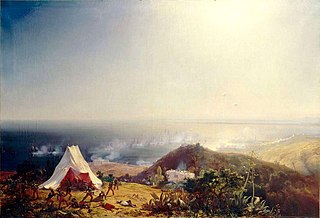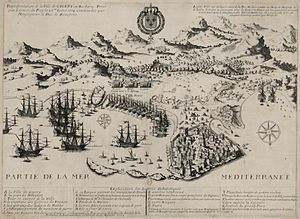
Pierre Adolphe Chéruel was a French historian.

The Regency of Algiers was a largely independent early modern Ottoman tributary state on the Barbary Coast of North Africa between 1516 and 1830. Founded by the privateer brothers Aruj and Hayreddin Barbarossa, also known as Oruç and Khayr ad-Din, the Regency began as an infamous and formidable pirate base that plundered and waged maritime holy war on European Christian powers. Ottoman regents ruled as heads of a stratocracy; an autonomous military government controlled by the janissary corps, themed Garp ocaklarılit. 'Western Garrison' in Ottoman terminology.

The invasion of Algiers in 1830 was a large-scale military operation by which the Kingdom of France, ruled by Charles X, invaded and conquered the Deylik of Algiers.

The French conquest of Algeria took place between 1830 and 1903. In 1827, an argument between Hussein Dey, the ruler of the Regency of Algiers, and the French consul escalated into a blockade, following which the July Monarchy of France invaded and quickly seized Algiers in 1830, and seized other coastal communities. Amid internal political strife in France, decisions were repeatedly taken to retain control of the territory, and additional military forces were brought in over the following years to quell resistance in the interior of the country.
Louis Nicolas de Clerville, a.k.a. Chevalier de Clerville, held many military positions during his life in France in 1610–1677. He was associated with Pierre-Paul Riquet and the building of the Canal du Midi.

The capture of Peñón of Algiers was accomplished when the beylerbey of Algiers, Hayreddin Barbarossa captured the fortress called Peñón of Algiers, on a small islet facing the Algerian city of Algiers from the Habsburg Spaniards.
The Battle of Wadi al-Laban occurred in March–April 1558 between Saadians and Ottoman Algerian forces under Hasan Pasha, the son of Hayreddin Barbarossa. It took place north of Fes, at Wadi al-Laban, an affluent of the Sebou River, one day north of Fes.

Igawawen or Gawawa, mostly known as Zwawa were a group of Kabyle tribes inhabiting the Djurdjura mountains, Greater Kabylia, in Algeria. The Zouaoua are a branch of the Kutama tribe of the Baranis Berbers.

Charles-Marie Denys, comte de Damrémont was a French general and military governor of French Algeria. He was killed in combat during the siege of Constantine.

The Kingdom of the Ait Abbas or Sultanate of the Beni Abbas was a Kabyle, Berber state of North Africa, then a fief and a principality, controlling Lesser Kabylie and its surroundings from the sixteenth century to the nineteenth century. It is referred to in the Spanish historiography as "reino de Labes"; sometimes more commonly referred to by its ruling family, the Mokrani, in Berber At Muqran. Its capital was the Kalâa of Ait Abbas, an impregnable citadel in the Biban mountain range.

The bombardment of Algiers in 1683 was a French naval operation against the Regency of Algiers during the French-Algerian War 1681–88. It led to the rescue of more than 100 French prisoners, in some cases after decades of captivity, but the great majority of Christian captives in Algiers were not liberated.

The Mokrani Revolt was the most important local uprising against France in Algeria since the conquest in 1830.
The Battle of Chelif or Battle of Djidouia took place on 28 April 1701 on the banks of the Chelif River. It was fought between the armies of the Alaouite Sultan Ismail Ibn Sharif and those of the Regency of Algiers commanded by the Bey of Mascara, Mustapha Bouchelaghem. It took place in the context of an attempt by the Alaouites to conquer the west of the Regency of Algiers, coordinated with an offensive by Tunis on the east of the Regency of Algiers in 1700 and 1701.

The French-Algerian War of 1681–1688 was part of a wider campaign by France against the Barbary Pirates in the 1680s.

The Campaign of Tlemcen (1551) was a military operation led by the Regency of Algiers under Hasan Pasha and his ally Abdelaziz, following the capture of Tlemcen by the Saadi Sultanate in June 1550.

The Raid on Reghaïa in May 1837, during the French conquest of Algeria, pitted the French colonizers in Reghaïa region against the Kabyle troops of the Igawawen confederacy.
Zawiyet Sidi Amar Cherif, or Zawiyet Sidi Daoud, is a zawiya school located in Boumerdès Province in Algeria.
The Shipwreck of Dellys took place in May 1830, during the French conquest of Algeria. It involved French troupes coloniales, under captains Félix-Ariel d'Assigny (1794-1846) and Armand Joseph Bruat (1796-1855), who were captured by the resistance fighters of the town of Dellys in Kabylia of the Igawawen.
Baba Ali, Also known as Bou Sebaa or Ali Melmouli or Baba Ali Neksîs was the 17th ruler and Dey of Algiers. He ruled for 11 years after his predecessor Mohamed Ibn Bekir.














